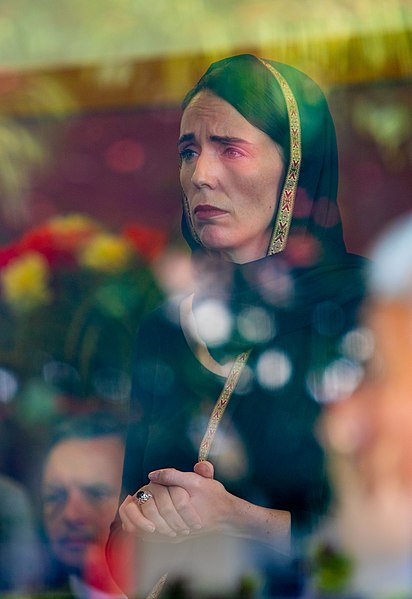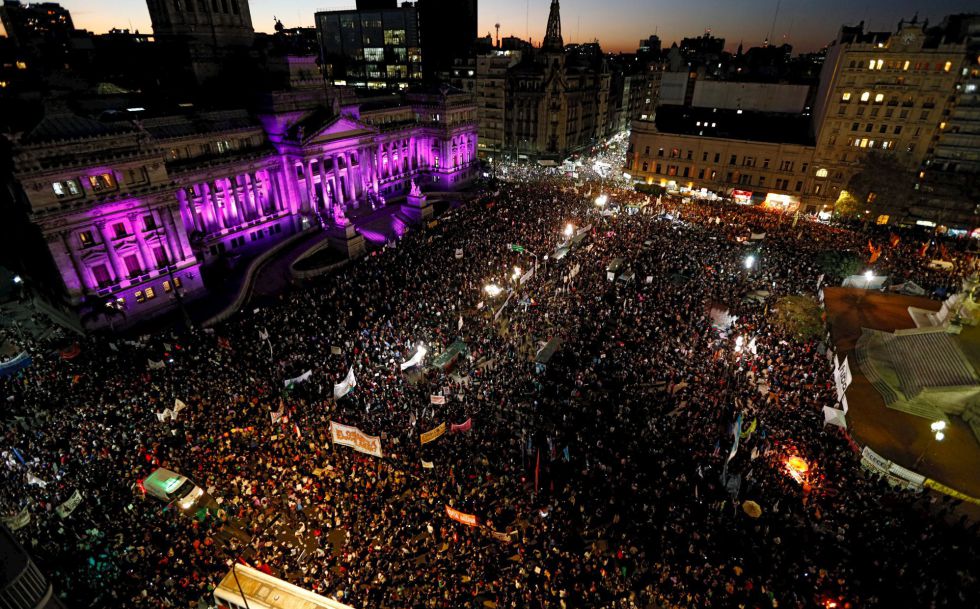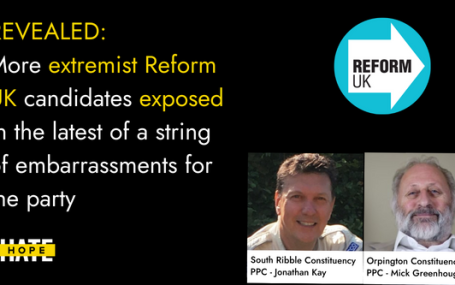HOPE not hate uses cookies to collect information and give you a more personalised experience on our site. You can find more information in our privacy policy. To agree to this, please click accept.
As we approach the end of 2019 it’s time to look back at what has proved a challenging and at times depressing year for those of us researching the international far right. Whether it was the spate of terror attacks or the further mainstreaming of hateful conspiracies, it has felt like we have been on the back foot, defending ground rather than progressing. Yet, when we take a closer look we also find small, important victories and many lessons we can learn from. Let’s take a look.
Ups and Downs
Entering 2019, many of the dregs of the ‘Alternative Right’ fell further into disarray; Milo Yiannopoulos’ debts mounted, The Proud Boys’ leader stepped down, and conspiracy theorist Alex Jones lost his platforms. Though solidarity within the international and particularly transatlantic far right did appear to start the year intact and research indicated considerable US/UK activity, a major split soon deepened between two key alt-right institutions and further efforts were made to form new alliances between the US and Europe.
More broadly, international networking continued, with conferences and gatherings across the globe seeing new efforts from both marginal and mainstream figures trying to forge closer international connections. Some of these, like the Conservative Political Action Conference grew (and grew), whilst others, for all their “super-powered brain control system[‘s]”, fostered nothing but endless, deserved ridicule.
Some of this networking also saw greater ideological cross-pollination, with activists meeting to share bigotry best practice. In many cases this saw a more explicit embrace of extremes, from British identitarians getting chummy with a bunch of neo-Nazis to American white nationalists hanging out with antifeminist Men’s Right’s Activists. Meanwhile, libertarians from across the globe met in Turkey to continue to be at odds with liberty by whitewashing the far right.
Making friends in new extremes, of course, is also a good indication of desperation and there certainly is some desperate circumstances out there for the international far right. One area which has seen a dramatic fall is the international ‘identitarian’ movement. American identitarians had to rebrand following leaks, whilst their British counterparts were cut adrift from their European network after they fraternised with the extreme far right, and the rest of the network were increasingly under pressure due to ties to the terrorist massacre in Christchurch. As one of its previous key supporters in Germany declared in November, the identitarians were “contaminated to the point of untouchability”.
Perhaps most significantly for the Anglophone far right, British anti-Muslim activist Stephen Yaxley-Lennon (AKA Tommy Robinson), who in 2018 was a focal point of international far-right support and momentum, fell into dire circumstances in 2019. This year saw him suffer devastating deplatforming blows, a humiliating defeat as a European election candidate and multiple legal woes.
Leaderless Hate in a Digital Age
These developments, however encouraging, have come alongside a growth in a more hostile far right and wider political climate. Journalists and others tracking the far right have seen continued harassment in 2019. As Melissa wrote in June, for example, Vox’s Carlos Maza had detailed a multi-year online homophobic and racist harassment campaign against him from US vlogger Steven Crowder.
In the UK, criminal abuse and harassment of MPs was reported to have increased to “unprecedented” levels, whilst in January the pro-refugee mayor of the Polish city of Gdansk, Paweł Adamowicz, was stabbed on stage and later died, and pro-refugee German MP Walter Luebcke was murdered in May by a far-right extremist who confessed to killing the MP so as to take “revenge” on his pro-refugee politics.
Beyond harassment, this year has also of course seen a spate of horrific far-right terrorist attacks. Whilst the 2019 Global Terrorism Index report from the Institute of Economics & Peace published in November highlighted that the “total number of deaths from terrorism declined for the fourth consecutive year”, they also noted that “incidents of far-right terrorism have been increasing in the West” with the total number increasing by “320 per cent over the past five years”. From January to September 2019 alone, “77 deaths [had] been attributed to far-right groups”.
We predicted in 2018 that the following year would see further far-right terrorist attacks but what we did not anticipate was their convergence in many cases with a broader trend in the far right. In HOPE not hate’s 2018 State of Hate report, my colleague Joe Mulhall wrote about how we appeared to be shifting into an increasingly ‘post-organisational’ far right landscape wherein a “decentralised collective of anonymous people” works in “broadly the same direction and towards similar goals” making it more difficult to monitor and undermine their activities. This had been the case for some time online, but it was a succession of far-right demonstrations in London in 2018 (not coincidentally perhaps in the same year that birthed the Yellow Vests demonstrations elsewhere) by activists who eschewed traditional parties and street movements with formal memberships, that brought the phenomenon truly offline.

The most high-profile far-right terror attacks in 2019, such as Christchurch and El Paso, showed this to be the case too, with there being a distinct online dimension to them which saw users encouraging terrorism albeit without strict direction from a leadership, and by perpetrators whose familiarity with these online spaces was clear. From the online publication of documents to specific sites outlining the details and motivations ahead of their attacks, to the use of livestreamed video during and the peppering of both with vocabulary common to these spaces, the intention in many cases appeared to be to further cultivate online pro-terror cultures and encourage others to carry out such acts.
These subcultures can be found in the nascent ‘Terrorwave’ subculture across multiple platforms which glorifies images of war and violence, in loose pro-terror Telegram communities, on the extreme far-right forums such as Fascist Forge and image boards 8kun (formerly 8chan) and 4chan, and within international networks such as ‘The Base’. Like users of the defunct Iron March before them, many within these online worlds explicitly endorse the concept of ‘leaderless resistance’: a term popularised by prominent Ku Klux Klan member Louis Beam, built on the premise of small cells acting without direct hierarchical command. As my colleague Patrik Hermansson wrote in April, a core threat of this post-organisational terror trend is its internationalisation; since “the application of the leaderless resistance tactic is by its nature difficult to counter, especially if applied across borders.”
More broadly, this convergence of an online anonymous mass with offline direct action reflects the ever greater blurring of the two in the far-right’s direct action and the refining of this as a propagandising tool. In August I wrote about such developments including but also beyond terrorism, from on-the-ground internet-style trolling to making sure an action can game an algorithm and gain traction online, and noted that a uniting feature was that the far right “perhaps more than ever are operating in a political arena in which their direct actions are concerned with their (news and social) media reception.”
Breaking Through?
Even if spectacle-inducing terror is the demand of the extreme far right, we should not inflate their influence nor assume that their message has in fact broken through and been a significant influence on others. Nonetheless, this year saw cases which left little doubt that hatred, whatever its catalysts, had been further mainstreamed. A clear example came during Trump’s racist targeting of four Democratic congresswomen of colour, including through tweets in August telling the four – who are all US citizens – to “go back” and “help fix the totally broken and crime infested” nations “from which they came”. That there is an audience to support this was reiterated a month prior at a North Carolina rally, when Trump’s supporters chanted “send her back!” after the President attacked one of these congresswomen directly in his speech.
Elsewhere particular far-right tropes, especially those with a conspiratorial angle, have received attention from mainstream politicians. From the ‘The Great Replacement’ and other identitarian ideas influencing far-right European Parliament election campaigns, to Britain’s Nigel Farage using the antisemitic ‘globalist’ dogwhistle and Conservative MP Suella Braverman using another, ‘Cultural Marxism’. On some topics and in some parts of the world, mainstreaming has gone even further. HOPE not hate polling released in June of this year highlighted the worrying extent of the British Conservative party’s supporters Islamophobic beliefs, including in once fringe Islamophobic tropes such as ‘no-go zones’.
When it comes to resisting the spread of far-right ideas, the culture war over deplatforming those who spread hate continued in 2019, with doing so continuing to be framed, often cynically by the far right, in terms of it being a danger to freedom of speech. Likewise, moral equivocating of the far-right and anti-fascists continued, not least from Trump who in April reiterated a form of his ‘both sides’ response that he first gave to the news of the murder of anti-racist demonstrator Heather Heyer in Charlottesville in 2017.Through CARD we also drew attention to some of the narratives and conspiracies which have begun to gain more of a footing, including the anti-LGBTQ+ and misogynist ‘Gender Ideology’ conspiracy which was central to the Polish far-right’s parliamentary election campaigns.
Around the World
We find ourselves with a fragmented fringe far right in many places, with activists and groups marginalised and with some turning more violent. Elsewhere, or in some cases despite this, we also have a mainstream right becoming more susceptible to conspiratorial and previously little-known far-right tropes. When it comes to responding adequately to this we should take note of some positive developments whilst recognising that more must be done. Major social media platforms are taking continued steps to battle hate, but it’s a mixed bag; Twitter’s recent changes to political advertising, for example, being too little too late in the eyes of many. Where extensive social media deplatforming has occurred it has been an undeniable success in undermining until recently significant far-right activists, from British anti-Muslim activist Stephen Yaxley-Lennon, to far-right conspiracy theorist Alex Jones and all-round troll and bigot Milo Yiannopoulos.
As the online world becomes ever more entangled in our political lives, however, new challenges are arising, from increased questioning of politicians’ rights to a social media platform if they abuse it, to a changing political disinformation landscape. Here too, there are lessons to learn from recent years about how to fight back, but we must continue to try and understand. Furthermore, whilst some governments are not giving due attention to the threat of the far right (or, indeed, are in their thrall), others are setting a shining example. Following Christchurch, New Zealand’s Prime Minister Jacinda Ardern showed how a government can respond to the current far-right terror without ceding ground to its perpetrators aims, and whilst ensuring respect is shown to the communities targeted and the lives lost or affected by such attacks.

Amongst these developments are some small, important advances and it perhaps predictable that these would be occurring now. Following the rupture on both sides of the Atlantic with Brexit and Trump amidst a wider global tide of populist radical right uprising, the middle of this decade placed many progressive movements into a state of confusion, as they wondered how we got here and how to respond. Given the immensity of the political rupture and the emergence of novel or rebranded forces, from ‘computational propaganda’ to ‘national populism’, it would take some time for the role and significance of these tools and ideas to be understood.
That we are in a better position to understand these developments is worth reminding ourselves of when the situation seems to be worsening in many parts of the world, and it is undeniable that this is so. In the US, following the Mueller Report and mid-Trump’s impeachment process, his Senior Policy Advisor Stephen Miller has had a trove of emails leaked which show his explicit support for the white nationalist far right. In the UK, alongside the continued upheavals of Brexit and the recent general election, the Conservative party is yet to solve its systemic Islamophobia, and Labour have only begun to make headway on their antisemitism problem.
This year saw a new far-right bloc form within the European Parliament which, despite the sighs of relief from some commentators at its small gains, should really be met with a sobering reminder that such a result would have been inconceivable just a few years ago. In Eastern Europe, there is less illusions following far-right parliamentary wins in Estonia and a worrying development in Poland’s far-right representation.
There have also been concerning developments outside of Europe. In China, the brutal persecution of the Uighurs continues, whilst Myanmar’s State Counsellor continues to deny that the 2016 Rohingya massacres were genocidal. In India, Narendra Modi’s government retained power following the largest election in history, allowing his Hindu Nationalist policies to be pushed further ahead including a recently passed citizenship law which will exclude Muslims. In Australia experts have warned that May’s low federal election results for the far right were more explicable by far-right parties’ leadership problems than “a lack of demand for extremist politics”.
South Africa’s Plaasmoorde or “Farm Murders” have been seized by the international far right as evidence of the prevailing far-right conspiracy of ‘white genocide’ (a narrative that was echoed by Trump in 2018). This has been partly pushed by South Africa’s domestic far right which have reached out to forge closer ties to their international sympathisers. In Japan, activists are attempting to act as bridge for the US right’s networking in continental Asia. In Russia, foreign political interference campaigns continue to spread hate globally, and persecution of LGBTQ+ people continues in Chechnya. In Brazil, far-right President Jair Bolsonaro continues to push politics to the extremes, attacking the environment, indigenous people, and threatening the rule of law.
New Challenges, New Hope
Beyond these challenges many of us are also entering new political terrain in the fight back against hate. Climate change has rocketed up the agenda globally, and the far right is taking note to begin co-opting this seismic topic to its ends. Likewise, the fight for transgender rights is becoming more mainstream and as reporting practices improves in many countries, spikes or the longer-term reality of anti-trans hate crime is being recorded. On 20November, the International Trans Day of Remembrance, the Trans Murder Monitoring project reported 331 cases globally of reported killings of “trans and gender-diverse people between 1 October 2018 and 30 September 2019”.
We must also be looking again at whether and how the ruptures from a few years ago have changed. Is the ire that fuelled the rise of Trump, Brexit and the international populist right surge still aimed at the same things? What will come of the far-right’s spread of conspiracy theories to the edges of the mainstream? How can we counteract the extreme, pro-terror far right that has grown in the darkest niches of the web? And if we are to find solutions together, how can we move past the back-and-forth over free speech?

Finding answers also requires finding hope. To understand how to respond to this multitude of challenges and changes we must first feel that we can. Looking back at 2019 there have been stories of success from which to find inspiration. Be it Puerto Rico and its citizenry’s mass protests against its governor’s homophobia, misogyny and alleged corruption following leaks, or in Hong Kong where protestors have faced down China’s efforts to impose an extradition bill which many feared could endanger activists. In New Zealand anti-fascists have gathered together to help fightback after the shock of Christchurch.
Across the world young people have shown that they will fight for their planet and, whilst not without criticism it must heed, Extinction Rebellion has engaged a huge number of people into activism. The Argentine feminist movement, #NiUnaMenos, started in 2015 in response to the murder of Chiara Paez by her boyfriend because she had become pregnant, has spread across the world. Just recently in Italy the ‘Sardines’ movement has begun standing up against Salvini and his Lega party and drew 40,000 people on to the streets in Florence. In August my colleague and comrade Melissa Ryan titled an edition of this newsletter ‘Despair is Not a Strategy’. Perhaps we should add too that hope is.

HOPE not hate reveals two more extremist candidates from Reform UK, in the latest of a string of embarrassments for the party UPDATE: Just hours…